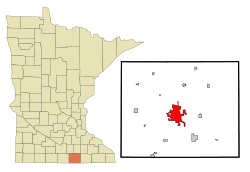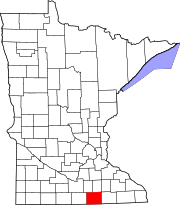|
Albert Lea, Minnesota
Albert Lea (/ˌælbərt ˈliː/ AL-bərt LEE)[5] is a city in Freeborn County, in southern Minnesota.[6] It is the county seat. Its population was 18,492 at the 2020 census.[3] The city is at the junction of Interstates 35 and 90, about 90 miles (140 km) south of the Twin Cities. It is on the shores of Fountain Lake, Pickerel Lake, Albert Lea Lake, Goose Lake, School Lake, and Lake Chapeau. Fountain Lake and Albert Lea Lake are part of the Shell Rock River flowage. The city's early growth was based on agriculture, farming support services and manufacturing, and it was a significant rail center. At one time it was the site of Cargill's headquarters.[7] Other manufacturing included Edwards Manufacturing (barn equipment), Scotsman Ice Machines, Streater Store fixtures, and Universal Milking Machines. As in many U.S. cities, Albert Lea's manufacturing base has substantially diminished. A major employer was the Wilson & Company meatpacking plant, later known as Farmstead and Farmland. This facility was destroyed by fire in July 2001. History The city is named after Albert Lea Lake, which was named after Albert Miller Lea, a topographer with the United States Dragoons, who surveyed southern Minnesota and northern Iowa in 1835, including the current site of Albert Lea.[8] Captain Nathan Boone, a son of Daniel Boone, was the scout for Lea's unit. The city received national attention in 1959 after Local 6 of the United Packinghouse Workers of America went on strike against Wilson & Co., one of the Big Four meatpacking plants at the time, over issues involving mandatory overtime requirements.[9] When Wilson & Co. attempted to operate the plant with replacement workers, violence erupted and split the town. During the 109-day strike, Governor Orville Freeman acted to quell the violence by closing the plant, calling in the Minnesota National Guard, and declaring martial law on December 11.[10] A federal district court in Minneapolis ruled against Freeman on December 23, and the plant turned back to Wilson & Co. just days later.[11] GeographyAccording to the United States Census Bureau, the city has an area of 14.42 square miles (37.35 km2), of which 12.59 square miles (32.61 km2) is land and 1.83 square miles (4.74 km2) is water.[12] Myre-Big Island State Park is nearby. There are three main lakes in Albert Lea: Fountain Lake, Pickerel Lake and Albert Lea Lake. ClimateAlbert Lea has a humid continental climate of the hot-summer subtype (Köppen Dfa). Albert Lea varies from cold winters to hot summers, with significant contrasts between seasons. Its climate type is typical for inland northern United States locations, but due to its southern position in the state, its summers and winters have higher temperatures than other, more northerly regions of the state. An exception to this rule is the urban core of Minneapolis - St. Paul, which sees higher temperatures typical of an urban heat island, but Albert Lea is significantly warmer than locations such as Duluth.
Demographics
2010 censusAs of the census of 2010, there were 18,016 people, 7,774 households, and 4,644 families living in the city. The population density was 1,431.0 inhabitants per square mile (552.5/km2). There were 8,410 housing units at an average density of 668.0 per square mile (257.9/km2). The racial makeup of the city was 90.0% White, 1.1% African American, 0.3% Native American, 1.1% Asian, 0.1% Pacific Islander, 5.3% from other races, and 2.1% from two or more races. Hispanic or Latino of any race were 13.2% of the population. There were 7,774 households, of which 25.6% had children under the age of 18 living with them, 45.0% were married couples living together, 10.4% had a female householder with no husband present, 4.4% had a male householder with no wife present, and 40.3% were non-families. 34.9% of all households were made up of individuals, and 17.3% had someone living alone who was 65 years of age or older. The average household size was 2.24 and the average family size was 2.85. The median age in the city was 44 years. 21.5% of residents were under the age of 18; 7.9% were between the ages of 18 and 24; 22% were from 25 to 44; 26.3% were from 45 to 64; and 22.4% were 65 years of age or older. The gender makeup of the city was 48.3% male and 51.7% female. 2000 censusAs of the census of 2000, there were 18,356 people, 7,785 households, and 4,826 families living in the city. The population density was 1,702.5 inhabitants per square mile (657.3/km2). There were 8,133 housing units at an average density of 754.3 per square mile (291.2/km2). The racial makeup of the city was 92.80% White, 0.37% African American, 0.29% Native American, 0.80% Asian, 0.03% Pacific Islander, 4.54% from other races, and 1.18% from two or more races. 9.48% of the population were Hispanic or Latino of any race. Of the 7,785 households, 26.9% had children under the age of 18 living with them, 49.5% were married couples living together, 9.1% had a female householder with no husband present, and 38.0% were non-families. 33.0% of all households were made up of individuals, and 16.8% had someone living alone who was 65 years of age or older. The average household size was 2.28 and the average family size was 2.88. 23.0% of Albert Lea's population were under the age of 18, 7.9% were 18 to 24, 24.6% were 25 to 44, 23.2% were from 45 to 64, and 21.3% were 65 years of age or older. The median age was 41 years. For every 100 females, there were 90.2 males. For every 100 females age 18 and over, there were 87.6 males. The median income for a household in the city was $32,841, and the median income for a family was $42,407. Males had a median income of $31,383 versus $21,114 for females. The per capita income for the city was $17,979. 10.2% of the population and 6.9% of families were below the poverty line. 10.6% of those under the age of 18 and 10.9% of those 65 and older were living below the poverty line. Arts and culture The Marion Ross Performing Arts Center is a historic building in downtown Albert Lea. The 255-seat theater is used for the arts, business meetings, and seminars.[16] The Freeborn County Fair takes place annually in Albert Lea, and includes live entertainment, an antique tractor show, a draft horse show, a small and baby animal show, a midway featuring rides, concessions, and other attractions, and a Sunday church service. A number of well-known and popular Country and Western bands have appeared at the Fair, including Kelly Pickler, Jason Aldean, the Oak Ridge Boys, the Statler Brothers, among many others.[17] The Albert Lea Art Center hosts public events.[18] SportsThe Albert Lea Thunder was a junior hockey team that played at Albert Lea Ice Arena and was a member of the North American Hockey League. The team operated for two seasons in 2008–10 and folded due to financial difficulties. On May 11, 2010, it was reported that the team had found new owners and would relocate to Texas for the 2010–11 season.[19] Its roster was sold to the expansion Amarillo, Texas, franchise the Amarillo Bulls on May 26, 2010.[20] GovernmentAlbert Lea's city hall is at 221 East Clark St. Albert Lea is in Minnesota's 1st congressional district, represented by Brad Finstad, a Republican from New Ulm.[21] It is in Minnesota State Senate District 23, represented by State Senator Gene Dornink, a Republican from Brownsdale, and in Minnesota's House District 23A, represented by Peggy Bennett, a Republican.[22] Presidential election results
Education
MediaThe Albert Lea Tribune, founded in 1897, is a newspaper published Monday through Saturday in Albert Lea. It is owned by Boone Newspapers.[24][25] Radio stations with Albert Lea as the city of license include:
Transportation Local bus service in Albert Lea is provided by SMART. SMART operates one deviated fixed route and paratransit service.[29] Notable people
See alsoReferences
External linksWikivoyage has a travel guide for Albert Lea. Wikimedia Commons has media related to Albert Lea, Minnesota. |
||||||||||||||||||||||||||||||||||||||||||||||||||||||||||||||||||||||||||||||||||||||||||||||||||||||||||||||||||||||||||||||||||||||||||||||||||||||||||||||||||||||||||||||||||||||||||||||||||||||||||||||||||||||||||||||||||||||||||||||||||||||||||||||||||||||||||||||||||||||||||||||||||||||||||||||||||||||||||||||||||||||||||||||||||||||||||||||||||||||||||||||||||||||||||||||||||||||||||||||||||||||||||||





